
16 minute read
1 Risks
The BMC recognises that climbing and mountaineering are activities with adanger of personal injury or death. Participants in these activities should beaware of and accept these risks andberesponsible for their own actionsand involvement
An important part of making the transition toclimbing outside is developing the art of balancing the skills you have available, againstthe challenges provided by the environment. That the sport involves risk is obvious to all, and this is an integral part of theactivity. It is important for each individual to identify a personally acceptable level of risk.
Advertisement
Minimising risks boils down to having the right level of skill and experience relative to the difficulty and seriousness of a given route. On a climbing wall different routes present afairly equal level of risk, irrespective of their difficulty. When climbing outside this is not the case, and the potential level of risk to which a climber is exposed does not equate to a route’s difficulty. This is one of the biggest differences an indoor climber must understand when climbing outside. Sustaining an injury on an easy sea cliff climb is likely to be more serious than having an accident at a roadside crag, and generally the amount of ‘safety’ or ‘danger’ involved comes from the climber, notthe rock.
We all have varied perceptions of what risk is and experience taking risks in different ways. When starting out choose the easiest routes available so that you are (hopefully!) still smiling when you finish them. In this way you find your limit by working up to it and so build a clear picture of the perceived and actual risks involved. Accidents often happen when people confuse these two very different concepts.
Imagine walking around at the top of a cliff where a slip over the edge could be fatal –theactual risk – but one can feel safe as the terrain is flat – the perceived risk. Climbing adifficult route with a top rope is very safe –theactual risk – (assuming the anchoris good, the belayer is paying attention etc) but the difficulty of the climb can induce a lot of fear –the perceived risk. Ask yourself lots of ‘what if’ questions, and in this way you can be objective about the risks to which you are exposed. Because experienced climbers strivevery hard to know their ownlimitations, the sport enjoys remarkably low accident rates. Incidents that make the headlines ofteninvolve individuals operating inenvironments for which they were ill-prepared, and this can give a somewhat skewed impression of thedangers involved in the sport.
Accidents can happen due to circumstances over which the climber has no control, such as rockfall, and in these events first aid training can make all the difference. As an absolute minimum all climbers should be familiar with basic emergency procedures, as outside help will always take time to arrive. Climbers should be especially aware that many serious accidents involve head injuries, and that wearing a helmet has on many occasions saved someone from more serious injury or death.
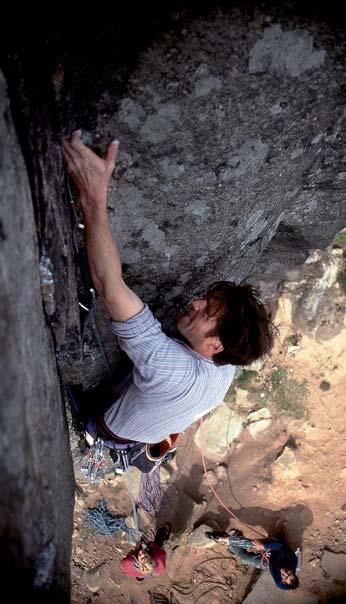
Hopefully it is obvious that your first outdoor climbs should be very much within your ability, without any unnecessary complications. It would be foolhardy to choose a weather dependent long mountain route with a complicated descent as your first climb!
Think about the type of route you are embarking on. An easy slab may provide fewer runner placements than an overhanging crack, and so a leader may be more likely to sustain an injury falling off the former than the latter – it’s not the falling off that’s the problem, it’s the hitting something on the way down that’s going to hurt!
Don’t just consider the grade when choosing climbs, identify your strengths and weaknesses and pick routes accordingly.
2 Clubs
Venturing outside can present problems if you have no regular partners to climb with. The BMC has over 350 affiliated clubs throughout the country ranging in size from over 1000 to under 10. Joining a club will give you access to a wealth of experienced people who can help develop your climbing skills. Some clubs offer introductory sessions and there is also the possibility of a pool of loan gear, shared travel, arranged trips at weekends and hut accommodation. All of which make getting started much easier.
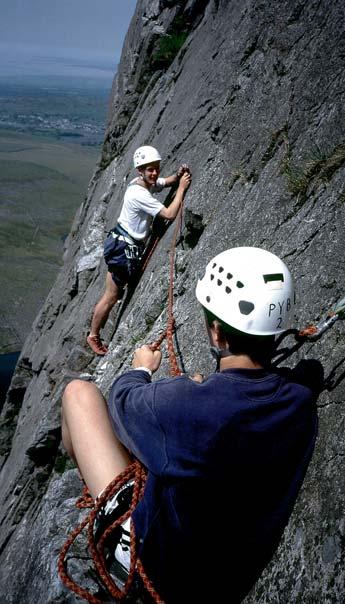
A list of climbing clubs is available at www.thebmc.co.uk, and a club near you can be easily located. All will welcome new members, but some are better equipped to cater for beginners and young people, so talk to them and find out before joining. There is guidance for BMC affiliated clubs on welcoming new members and introducing novices, as well as practical events such as seminars and lecture series.
3 Young Climbers
Climbing is part of our childhood: scaling trees, sneaking over walls, exploring rock pools, steppingstone games – so you’re already a natural! Having opportunities to develop your skills further is often the biggest obstacle.
Youth Participation Statement:
Parents and young participants should beaware that climbing, hillwalking and mountaineering areactivities withadanger of personal injury or death. Parents and participants intheseactivities should be aware ofand accept these risks and be responsible for their own involvement.
Young climbers can find it difficult to get involved in climbing, particularly if their parents, or persons with parental responsibility, are non-climbers. Some clubs do not want the responsibility of accepting people under 18 years old, as they are concerned about liability issues. It is therefore essential that written parental consent is given, and that both parent and child are fully aware of the activities to be undertaken and their associated risks. Advice on child protection issues, liability and event organisation is available from the BMC office. Check out the BMC website for clubs that welcome young members. Young climbers must be fully aware of and accept the risks involved in climbing in the same way as adults. The more experienced and mature a child is, the more able they are to understand and manage risk.
Tuition and clubs
If tuition is being given to young novices then a greater burden of responsibility falls on the climber providing guidance, than if the novices were adults. This climber does not have to be qualified but must be competent in assisting theless experienced. If professional outdoor instruction is being given to minors then organisations delivering this must be registered with the Adventure Activities Licensing Authority (AALA).
As well as BMC clubs, there are other organisations such as the youth service,
4 The Environment
Climbing activities often take place in areas of outstanding beauty and great landscape value. Asmost cliffs in Britain are on private land access is given only at the consent of the owner, and one of the most important areas of the BMC’s work is in Access and Conservation. Following the introduction of the Countryside and Rights of Way Act (CRoW Act), there is now a statutory right of access to some crags, moors and mountains for all outdoor users.
schools and climbing walls where young people can participate on a regular basis. Once involved, the BMC can offer advice toadults and young participants through theBMC Area Youth Co-ordinator network ontraining, equipment and injury prevention.
The BMC has a Child Protection Policy and guidelines, which is designed to protect both young people and support those looking after them. The guidelines are followed whenever aBMC Youth Meet is run. The policy also helps those working with young people by specifying what constitutes good practice whenworking with this age group.
Young people and their parents should visit www.thebmc.co.uk for more information.
Competition climbing
The BMC is involved in running indoor climbing competitions, which are open to everyone. Even if you feel that competition climbing is not for you, these events are a great opportunity to meet other young climbersliving in your area.
The British Regional Youth Climbing Series (BRYCS) is for climbers aged 7 to 15 with regional events held throughout the country and a national final. Climbers aged 12 and upwards can also compete in the British Indoor Climbing Championships (BICC), and the British Bouldering Championships (BBC).
Many popular climbing venues are important sites for wildlife such as nesting birds and rare floral species, and restrictions used to protect sensitive wildlife can prevent climbing. Many sea-cliffs have a range of restrictions during the nesting season from February to July. Numbering over 100 each year and negotiated between the BMC and other conservation bodies they are listed on our Regional Access Database –www.thebmc.co.uk/outdoor/rad/rad.asp. It is vital that these restrictions are respected, otherwise access which the BMC has carefully secured, could be lost forever.
All upland plants grow in very harsh environmental conditions, cliff vegetation especially so. Flowers growing in thin cracks with a minimum of soil and few nutrients are easy to destroy. It may appear a small loss to remove a few plants, but if other climbers are doing the same then whole cliffs can get stripped of vegetation. Other potential environmental impacts of climbing include footpath erosion, rock abrasion, and damage to trees from abseil ropes.
As a general rule, rocks that are good for climbing are not usually good for plants, and vice versa. Plants of conservation interest typically like damp, nutrient rich, friable rocks with plenty of loose flakes and pockets. Most traditional venues are therefore not botanically rich, but where they are and where there is a conflict between climbing and conservation interests, agreements are generally worked out.
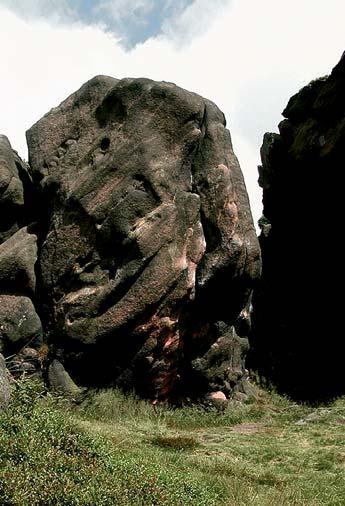
We all have an equal responsibility to preserve our finite climbing resources and need to tread lightly, making sure we leave the crags and boulders we love so dearly as we would like to find them.
CASE STUDY: Hawks Stones, Yorkshire
Situated on private land, the owner famously banned access in the late1960s. For many years the BMC was involved in negotiations, but the situation became exacerbated through errant climbers ignoring the restrictions. Due to the implementation of the CRoW Act, this crag has now been defined as situated on Open Access Land, giving climbers and walkers almost unlimited access to the open moorland, main cliff and surrounding boulders.
Due to the historical difficulties with access, the close proximity of the landowner’s house, and for the sake of future relations, the BMC has agreed to implement a number of concessions designed to conserve the surrounding habitat and maintain biodiversity at the crag. No dogs are allowed due to the presence of rare-breed sheep and ground nesting birds; aclearly defined access route has been created; no human waste please – the moor is a catchment area for the house’s water supply; due to tree planting, keep to the land directly below the crag; keep all noise to a minimum.
It is undoubtedly wonderful news that the CRoW Act will provide access to previously restricted areas, but the vegetation and wildlife at venues like Hawks Stones have been undisturbed for over thirty years. The renewed access demonstrates that even though we now have a legal right to enjoy new areas, with it comes a moral duty to respect the welfare of the people and wildlife living there permanently.
With many climbers, hill walkers and mountaineers visiting our cliffs and mountains, it is the responsibility of us all to ensure that the natural character of the countryside is protected. In order to preserve the access we enjoy today for future generations of outdoor users, it is vital to maintain good relations with farmers, landowners and local residents.
The Access & Conservation Trust –www.accesstrust.org.uk – funds projects that aid access and conserve the landscape. Its work relies on donations and the help of its partners and supporters, so please support the trust and enable this vital work to continue.
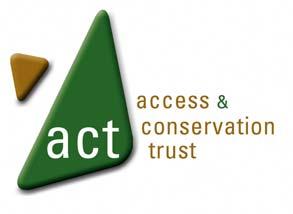
5 History and Ethics
Climbing does not really have any rules. There is no offside, no handball and no penalty boxes, and this is one of the things that make it great. Most people accept that you do not damage the rock and environment in any way, and that whatever you do you should be honest about it, but beyond that, you are free to enjoy climbing in whatever way you want, and the more fun you have while doing this thebetter.
However, what climbing does have are ethics. Ethics are a code of behaviour that people generally accept as being good things, and are used as a guide to the challenges that climbers set themselves. A very simple example of this is trying to do a route without falling off, or trying to do a boulder problem on your first try. This is because it is generally accepted that these are the best ways to do them.
A lot of the ethics in climbing revolve around the preservation of adventure. The challenges of climbing spread far beyond the purely physical. The management of risk is a huge part of it, as is the journey into the unknown. As such, many climbers seek to preserve the risk and unknown sides of the sport. The UK has a great tradition of bold climbing, climbing where reliance is placed on the climbing party, giving great rewards to all concerned. Many people worry that if bolts appear on all routes, then this adventure will be lost. As such, there are ethics involving the placing of bolts.
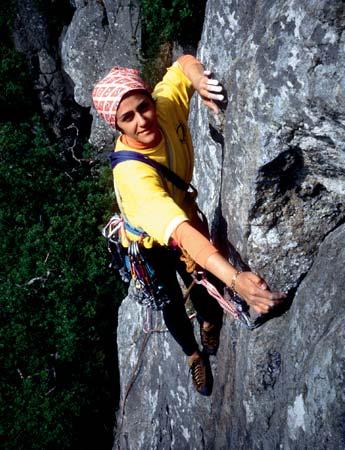
Another example of ethics is how people try to climb ‘on-sight’. This means leading a route that you have no prior knowledge about, without falling off. In this way, the climb is more of a challenge.
Most of these ethics have been confirmed by over a century ofendeavour on the rocks. Through the need to meet the challenges of climbing head-on, climbers have often been pushed to their limits, and the results have been amazing achievements and stories of adventure. To findout more about all this, and to get an appreciation of the development of the sport and why it is the way it is today, it is a good idea to read some history of the sport.
The easiest place to find any of this is in the history section of a climbing guide. These will often recount the most notable stories of a
6 Grades
Routes on indoor walls are graded using sport grades. However there is no like for like comparison to be made with an outdoor route of the same grade as an indoor one. This is because outdoor climbing relies on many more skills than indoor climbing. Indoor climbing tends to be on steep ground with positive holds, all coloured and set out in order, and as such, tends to rely a lot on strength.
Outdoor climbing requires the ability to recognise holds, read sequences and involves more friction moves and jamming in cracks. Generally it is less steep and relies more on balance.
It is important not to find this off putting. When moving outdoors for the first time, try not to have your expectations guided too much by the grades that you climbed indoors.
It is best to drop down a lot of grades as you start out, as this will give you the chance to learn the skills needed for outdoors in more comfort and safety. It is not much fun for your first outdoor experiences to be desperate struggles. Try to relax and enjoy it.
You will need to understand how grades work. This, surprisingly, can be a complicated local area. As well as being interesting reading, these histories can bring a lot of extra life to climbs. You might find out that a climb that you did was the most ferocious climb in the country in 1915, or that you have just climbed a Joe Brown classic. This sense of history brings extra rewards to a climb. job, due to the number of different styles of climbing, and the number of grades that exist for each. There are, amongst others, iceclimbing grades, aid-climbing grades, big-wall grades and Alpine grades. However, these are generally for more advanced climbers. For people moving outdoors for the first time, there are three main grading systems: sport grades, bouldering grades and traditional grades.
So as you venture forth onto the rocks, try to be aware that all this is more than just exercise. Try to understand that through a century of climbing, there has developed a set of ethics as to how you should aspire to climb. And remember that these are not rules to tell you what is disallowed, but are guides that can show you how to get the most from your climbing. Respect the rock, be honest, and enjoy yourself.
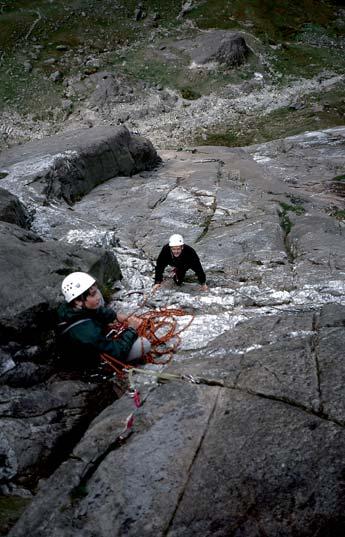
Sport grades
These are perhaps the easiest to understand, as they will be the same grades used for routes indoors – using traditional grades for indoor climbs does not transfer to outdoor climbing. The sport grade tells you how technical, pumpy or powerful a route is. It doesn’t account for how exposed it might be. They are for routes that are fully protected by bolts and graded using the French system, which runs from 3 to 9b+ (3, 4, 4+, 5, 5+, 6a, 6a+, 6b, 6b+, 6c, 6c+, 7a…9b, 9b+). Sometimes there might be the letter F in front to
A comparative table of climbing grades
help identify it. Many countries have their ownsystems, and grade comparison charts are common in guidebooks to show how eachcompare.
Traditional grades
Traditional grades are grades given to roped climbs that rely on the leader placing their own protection. The system, as used in the UK, can seem complicated at first. It has two parts to it, an adjectival grade and a technical grade. The adjectival grade gives an idea of how pumpy, exposed or safe a climb is. For historical reasons, and to further complicate things, it runs from E, M, D, V Diff, S, HS, VS, HVS, E1, E2…E10. The technical grade gives an idea of how hard the hardest moves on the climb are. Once again, this system resembles sport grades, and runs 3c, 4a, 4b, 4c, 5a… 7c. This leaves grades like VS 4c, E3 6a etc.
It is a system unlike those used indoors, butonce understood gives a lot of information about a climb. For example, a VS climb –VerySevere – usually has a technical grade of 4c, and a VS 4c climb should have adequate protection. A VS 4a climb is very likely to have little protection, like many slab routes. AVS 5a climb will have lots of protection for the 5a moves. Climbers describe themselves as ‘VS leaders’ or ‘E2 leaders’ as the adjectival part of the grading system gives a very good description of the overall feel of the route.
Bouldering grades
These are grades for boulder problems, and in the UK there are currently several systems in use. There is the Fontainebleau system, developed in the famous boulders just outside Paris, and runs from 3 to 8c, in much the same way as the sport grades above. Unfortunately,
Bouldering grades
USA V gradesFrench
(UsedintheUK) system
7 Bouldering
At every stage in your climbing career you will benefit from bouldering. Your body learns a broadening repertoire of muscular adjustments andthe mind adjusts to noticing opportunities formovement and recovery.
Bouldering outside requires no extra equipment to that used in a wall, but bouldering pads are becoming increasingly popular. They absorb some of the impact force when landed on, and so can reduce both ground erosion and the likelihood of sustaining an injury when falling off.
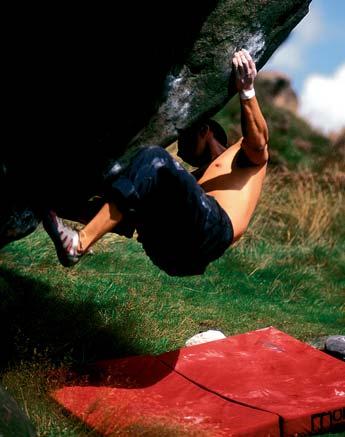
Conservation
Source: North Wales Bouldering, Simon Panton while they look the same, they are very different. Sometimes they might have Fb, Font or bloc (French for boulder) in front of them, but not always. There is also the American V system, which is much simpler as it runs from V0, V1, V2 to V15. There is also the B system, which is much like the V system. Like sport grades, boulder grades account for technicality, pumpiness or power, although problems that are very high up sometimes have slightly higher grades.
These are the three most basic types of grades that you will meet as a novice to the outdoors. Try not to be too daunted or guided by them. While they seem complicated and easily confused to begin with, experience will soon begin to make sense of them, and before you know it, you will easily tell your sport 6as from your Font 6as from your technical 6as.
A lot of vegetation on boulders is heather and grass, but some venues are home to less common species. There is always a chance that a site with protected plants may be developed, and for this reason you should not do any gardening. Vegetation gets eroded by climbers wandering between boulders and falling off problems, and many popular venues have suffered greatly. Pads can prevent further erosion.
BOULDERING: Conservation issues
•No chipping
•No wire brushing –use a nylon brush if cleaning holds
•Use bouldering pads to reduce ground erosion and vegetation damage
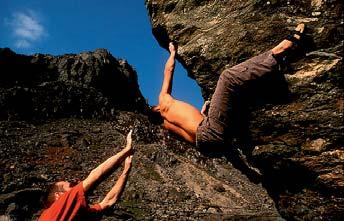
•Clean and dry your footwear to reduce rockdamage
•Don’t use resin (pof)
•Minimise chalk use –brush away any excessive build up
•Dry wet holds with a towel or wait until awindy day – no blowtorching please
•Remove carpet patches or towels –they kill off vegetation and create a mess
•Take all litter home and follow the CountrysideCode
•Leave vegetation in place – no gardening please
If a particular venue is becoming damaged, some well thought out management techniques can maintain access and prevent further erosion. The landowner will need consulting; this could be an individual or organisation such as the National Trust. If the welfare of rare plants or animals is an issue then the Countryside Council for Wales, English Nature or Scottish Natural Heritage may be involved. Finally, many of our popular climbing venues are in National Parks, whose authorities oversee the recreational management of these scenic areas. When there is an access issue the BMC actively negotiate to protect the interests of climbers.
Happy landings
Landing safely from a boulder problem is quite an art. Try to anticipate the likely flight path resultant from failure, not always easy, but with growing experience you should be able to work out suitable padding arrangements. It is worth remembering that whilst a high fall onto a flat padded surface can be fine, a low level slip onto uneven ground could result in serious injuries.
The main area where even well seasoned boulderers tend to fail is in the basic act of spotting – guiding a falling climber to a landing zone by supporting their back. Spotting is not catching! Consider a problem where a fall may result in your partner tumbling backwards. With your hands close to their back they will hardly accelerate before you can guide them. Conversely, even if only a metre or so above you, they will accelerate a great deal, possibly injuring you. This does not mean that on high problems you can simply stand around with hands in pockets; a spectator as your partner lands in a crumpled heap! You can still do agreat deal to guide them into the padded area, keeping them in an upright position ifpossible, but be careful not to get injured yourself. Remember that just as boulderers falloff without warning, so holds can break unexpectedly – pay attention all the time.
You should not underestimate the potential violence of a fall, even from a low position. Astrong climber exploding backwards from abunched up position will do so with a terrific amount of force, and as a responsible spotter you must ensure that you are best prepared todeal with this eventuality. A pad will absorb some of the impact force in these situations and so can reduce the likelihood of injury –but only if landed on. As pads protect vegetation you should try to stand on one when spotting.
Bouldering is a great group activity. You can learn from watching others, experimenting with new techniques as you go. With more pads and people, the safety margins increase, useful when spotting those high scary problems.





